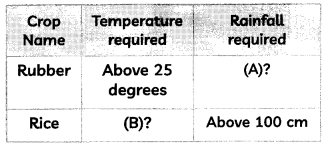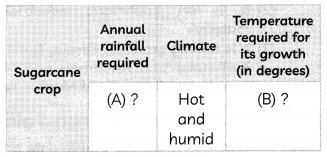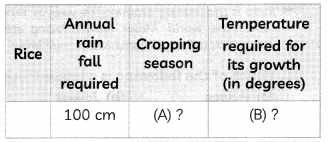Agriculture Class 10 MCQs Questions with Answers
Question 1.
Fill in the blank by choosing the most appropriate option:
Muskmelon grows in ………
(a) Rabi season
(b) Kharif season
(c) Zaid season
(d) They are grown in both Zaid and Rabi seasons.
Answer:
(c) Zaid season
Explanation: Muskmelon is grown in the Zaid Season. Zaid season comes between Kharif and Rabi season.
Question 2.
Which of the following pulses do not help in restoring soil fertility?
(a) Moong
(b) Gram
(c) Peas
(d) Arhar
Answer:
(d) Arhar
Explanation: Pulses need less moisture and survive even in dry conditions. All leguminous crops or pulses except arhar help in restoring soil fertility by fixing nitrogen from the air. Therefore, these are mostly grown in rotation with other crops.
Question 3.
Coffee cultivation was first introduced in:
(a) Himalayas
(b) Aravalli Hills
(c) Garo Hills
(d) Baba Budan Hill
Answer:
Question 4.
What percentage of our cropped area is covered by oilseeds?
(a) 21%
(b) 12%
(c) 2%
(d) 40%
Answer:
(b) 12%
Question 5.
Which one of the following is not true for pulses?
(a) Pulses are grown in both Kharif and Rabi Seasons.
(b) Pulses require intensive and excessive irrigation facilities
(c) They are grown in rotation to replenish fertility of the soil.
(d) Pulses are leguminous crops.
Answer:
(b) Pulses require intensive and excessive irrigation facilities
Explanation: Pulses need less moisture and survive even in dry conditions.
Question 6.
If rice is a commercial crop in Haryana and Punjab, in which state is it a subsistence crop?
(a) Odisha
(b) Maharashtra
(c) Uttar Pradesh
(d) Rajasthan
Answer:
(a) Odisha
Question 7.
From which of the following countries was the Arabica variety of coffee initially brought to India?
(a) Yemen
(b) Nepal
(c) Britain
(d) China
Answer:
(a) Yemen
Question 8.
Which of the following is an equatorial crop but is also grown as a subtropical and tropical crop?
(a) Jute
(b) Wheat
(c) Rubber
(d) Cotton
Answer:
(c) Rubber
Question 9.
The state of is a major producer of Jute.
(a) Andhra Pradesh
(b) Maharashtra
(c) Madhya Pradesh
(d) West Bengal
Answer:
(d) West Bengal
Question 10.
Ragi has high nutritional value and is rich in
(a) Iron, calcium
(b) Magnesium
(c) Phosphate
(d) Vitamin C
Answer:
Question 11.
Why is there enormous pressure on agricultural land in India? Choose the correct option:
(a) Landholding size is very small.
(b) High density of population.
(c) Small scale farmers do not have the technology to have a lot of produce.
(d) Farmers of less land holdings are not able to afford the right techniques of farming.
Answer:
Question 12.
Fill in the blank by choosing the most appropriate option:
Intensive Subsistence Farming- Labour intensive and Machine based; Primitive Farming-
(a) Machine based
(b) Traditional methods based
(c) Labour intensive
(d) Modern
Answer:
(b) Traditional methods based
Question 13.
Which group of crops can be classified under the classification of millets?
(a) Maize and Wheat
(b) Sesamum and Groundnut
(c) Urad and Arhar
(d) Bajra and Ragi
Answer:
(d) Bajra and Ragi
Question 14.
Match the items of Column A with that of Column B.
| Column A (Fruits) | Column B (Significant Areas of Growth) |
| (A) Guava | (I) Jammu and Kashmir |
| (B) Orange | (II) Kerala |
| (C) Apple | (III) Uttar Pradesh |
| (D) Banana | (IV) Maharashtra (Nagpur) |
Answer:
(a) (A)-(II), (B)-(IV), (C)-(I), (D)-(III)
(b) (A)-(IV), (B)-(III), (C)-(II), (D)-(I)
(c) (A)-(III), (B)-(IV), (C)-(I), (D)-(II)
(d) (A) -(I), (B) – (III), (C) -(II), (D) -(I)
Question 15.
Which type of farming has the use of higher doses of modern inputs, e.g. high yielding variety (HYV) seeds, chemical fertilisers, insecticides and pesticides?
(a) Primitive subsistence
(b) Plantation farming
(c) Small Farming or Zero Based Farming
(d) Commercial Farming
Answer:
(d) Commercial Farming
Question 16.
Read the table and fill in the blank by choosing the most appropriate option:

(a) (A) More than 500 cm, (B) Below 20 degrees
(b) (A) More than 100 cm, (B) Above 40 degrees
(c) (A) More than 200 cm, (B) Above 25 degrees
(d) (A) less than 100 cm, (B) Above 20 degrees
Answer:
(c) (A) More than 200 cm, (B) Above 25 degrees Explanation: Rubber requires a moist and humid climate with rainfall of more than 200 cm and a temperature above 25°C.
Rice is a kharif crop which requires high temperature, (above 25°C) and high humidity with annual rainfall above 100 cm. In areas of less rainfall, it grows with the help of irrigation.
Question 17.
Which of the following is a rabi crop?
(a) Rice
(b) Gram
(c) Millets
(d) Cotton
Answer:
(b) Gram
Explanation: Rice, millets and cotton are kharif crops grown with the onset of monsoon in parts of the country and harvested in September- October.
Related Theory
Rabi crops are sown in winter from October to December and harvested in summer from April to June. Some of the important rabi crops are wheat, barley, peas, gram and mustard while in between the rabi and the kharif season, a short season is known as the Zaid season. Crops grown in this short season are watermelon, muskmelon, cucumber, vegetables and fodder crops.
Question 18.
Which of the following is an age-old economic activity in our country?
(a) Mining
(b) Agriculture
(c) Sericulture
(d) All of these
Answer:
(b)Agriculture
Explanation: India is an agriculturally important country. Two-third of its population is engaged in agricultural activities.
Question 19.
Which of the following price is announced by the government in support of a crop?
(a) Minimum Subsidised Prices
(b) Maximum Support Prices
(c) Minimum Support Prices
(d) Maximum Subsidised Prices
Answer:
(c) Minimum Support Prices
Question 20.
Given below are some geographical conditions required for the growth of tea crops in India except one. Find it out:
(a) Tea is a labour intensive industry
(b) It requires warm and moist frost-free climate all through the year
(c) It grows well in tropical and sub-tropical climates
(d) It is a beverage crop introduced by the British in India.
Answer:
(d) It is a beverage crop introduced by the British in India.
Explanation: Tea is plantation agriculture and was introduced by the British in India.
Related Theory
India is the leading producer as well as exporter of tea in the world. Major tea-producing states are Assam, I/Vest Bengal, Tamil Nadu and Kerala.
Question 21.
Which of the following is a leguminous crop?
(a) Pulses
(b) Jowar
(c) Millets
(d) Sesamum
Answer:
(a) Pulses
Explanation: India is the largest producer as well as the consumer of pulses in the world.
Related Theory
Pulses are the major source of protein in a vegetarian diet. Major pulses grown in India are tur (arhar), urad, moong, masur, peas, and gram.
Question 22.
The ‘slash and burn’ agriculture is known as ‘Milpa’ in which country?
(a) Indonesia
(b) Vietnam
(c) Brazil
(d) Mexico
Answer:
Question 23.
Barley, peas, gram, wheat, and mustard are grown in which cropping season?
(a) Kharif season
(b) Rabi season
(c) Zaid season
(d) All of these
Answer:
(b) Rabi season
Question 24.
Being leguminous crops, pulses help in restoring soil fertility by fixing nitrogen from the air except:
(a) Urad
(b) Arhar
(c) Moong
(d) Masur
Answer:
(b) Arhar
Explanation: Arhar is also known as tur.
Question 25.
Which of the following right leads to the division of land among upcoming generations in India?
(a) The right to property
(b) The right of inheritance
(c) The right of successor
(d) None of these
Answer:
(b) The right of inheritance
Question 26.
Arrange the following in the correct sequence:
(i) Sugar
(ii) Transport
(iii) Grocery Item
(iv) Sugarcane
Options:
(a) (i)—(iv)—(iii)—(ii)
(b) (iii)—(iv)—(i)—(iO
(c) (iv)—(i)—(ii)—(iii)
(d) (iii)—(iv)—00—0)
Identify the following on basis of the hints given.
Question 27.
Identify the following product:
(1) The Arabica variety initially brought from Yemen is produced in the country.
(2) Its cultivation was introduced on the Baba Budan Hills
(3) Today it is cultivated in Nilgiri in Karnataka, Kerala and Tamil Nadu.
Answer:
Coffee
Question 28.
Identify the following crop:
(1) It requires a moist and humid climate with rainfall of more than 200 cm and temperature above 25°C.
(2) It is an important industrial raw material.
(3) It is mainly grown in Kerala, Tamil Nadu, Karnataka dnd Andaman and Nicobar islands and Garo hills of Meghalaya.
Answer:
Correct & Re-write / True-False
State whether the following statements are True or False. If false, correct the statement.
Question 29.
The Arabica variety initially brought from Saudi Arabia is produced in the country.
Correct statement is as follows:
Answer:
The Arabica variety initially brought from Yemen is produced in the country.
Question 30.
Cotton requires high temperature, 220 frost- free days and heavy rainfall for its growth.
Correct statement is as follows:
Answer:
Cotton requires high temperature, 210 frost- free days and light rainfall for its growth.
Question 31.
The ‘right of inheritance’ leading to the division of land among successive generations has rendered land-holding size economical.
Correct statement is as follows:
Answer:
The ‘right of inheritance’ leading to the division of land among successive generations has rendered Land-holding size uneconomical
Question 32.
Rice a rabi crop, is grown with the withdrawal of monsoon in different parts of India.
Answer:
Question 33.
Maize is a crop which is used both as food and fodder.
Answer:
True
Question 34.
India is the third-largest producer of Rice after China and Pakistan.
Answer:
False
India is the second-largest producer of Rice after China.
Related Theory
Rice is a kharif crop that requires high temperature, (above 25 degrees C) and high humidity with annual rainfall above 100 cm. It grows in plains of North and North-eastern India.
Fill in the blanks/tables with suitable information:
Question 35.
Complete the following table with correct information for A and B:

Answer:
(A) 75-100 cms
(B) 21°C to 27°C
Explanation: Sugarcane grows well in a hot and humid climate with temperature of about 21-27°C.
Brazil is the largest producer of Sugarcane in the world.
Question 36.
………….. is a ‘slash and burn’ agriculture. Farmers clear a patch of land and produce cereals and other food crops to sustain their family.
Answer:
Primitive Subsistence Farming
Explanation: Primitive subsistence farming is known as Jhumming in north-eastern states like Assam. Meghalaya, Mizoram and Nagaland. Pamlou in Manipur, Dipa in Bastar district of Chhattisgarh, and in Andaman and Nicobar Islands.
Related Theory
The slash and bum agriculture is known as ‘Milpa’ in Mexico and Central America, ‘Conuco’ in Venezuela, ‘Roca’ in Brazil, ‘Masole’ in Central Africa, ‘Ladang’ in Indonesia, ‘Ray’ in Vietnam.
Question 37.
India is the …………. producer of sugarcane in the world.
Answer:
Question 38.
Complete the following table with correct information with regard to cultivation of Rice:

Answer:
(A) Kharif Cropping Season
(B) 16°C – 27°C.
Match the Columns
Question 39.
Match the following crops from column A with the states these are grown in from column B:
| Column A (Crops) | Column B (States) |
| (a) Tea | (i) Uttar Pradesh |
| (b) Wheat | (ii) Karnataka |
| (c) Coffee | (iii) Punjab |
| (d) Sugarcane | (iv) Assam |
Answer:
| Column A (Crops) | Column B (States) |
| (a) Tea | (iv) Assam |
| (b) Wheat | (iii) Punjab |
| (c) Coffee | (ii) Karnataka |
| (d) Sugarcane | (i) Uttar Pradesh |
Question 40.
Match the following terms from column A with their meanings from column B:
| Column A (Terms) | Column B (Meanings) |
| (a) Horticulture | (i) Grown with the onset of monsoon |
| (b) Sericulture | (ii) Grown in winter season |
| (c) Robi Crops | (iii) Cultivation of fruits and vegetables |
| (d) Kharif Crops | (iv) Production of silk |
Answer:
| Column A (Terms) | Column B (Meanings) |
| (a) Horticulture | (iii) Cultivation of fruits and vegetables |
| (b) Sericulture | (iv) Production of silk |
| (c) Robi Crops | (ii) Grown in winter season |
| (d) Kharif Crops | (i) Grown with the onset of monsoon |
Question 41.
Match the following crops given in Column A with the states they are found in Column B. Choose the correct answer from the options given below:
| Column A | Column B |
| (a) Cotton | (i) Uttar Pradesh |
| (b) Jute | (ii) Maharashtra |
| (c) Wheat | (iii) Rajasthan |
| (d) Bajra | (iv) West Bengal |
Answer:
Assertion Reasoning questions Class 10 Geography Chapter 4
In each of the following questions, a statement of
Assertion (A) is given followed by a corresponding statement of Reason (R). Select the correct answer to codes (a), (b) (c) or (d) as given below:
(a) Both (A) and (R) are true and (R) is the correct explanation of (A).
(b) Both (A) and (R) are true but (R) is not the correct explanation of (A).
(c) (A) is correct but (R) is wrong.
(d) (A) is wrong but (R) is correct.
Question 42.
Assertion (A): The Government of India buys wheat and rice from farmers at a fair price.
Reason (R): The public sector contributes to economic development.
Answer:
(b) Both (A) and (R) are true but (R) is not the correct explanation of (A).
Explanation: The government announces the minimum support price and remunerative and procurement prices for important crops to avoid the exploitation of farmers by speculators and middlemen. It buys crops from farmers at a fairer price to boost their living.
Question 43.
Assertion (A): Indian agriculture finds itself at a crossroads.
Reason (R): Though the GDP growth rate is increasing over the years, it is not generating sufficient employment opportunities in the country
Answer:
(a) Both (A) and (R) are true and (R) is the correct explanation of (A).
Explanation: Indian agriculture is growing but there is a deceleration in this sector. Employment opportunities are not increasing.
Question 44.
Assertion (A): Stagnation in agriculture will not lead to a decline in other spheres of the economy having wider implications for society.
Reason (R): All three economic sectors are dependent on each other.
Answer:
(d) (A) is wrong but (R) is correct.
Explanation: Stagnation in agriculture will lead to a decline in other spheres of the economy having wider implications for society.
Question 45.
Assertion (A): The Government of India made concerted efforts to modernize agriculture.
Reason (R): Indian farmers are facing stagnation in production due to inferior technology.
Answer:
(a) Both (A) and (R) are true and (R) is the correct explanation of (A).
Question 46.
Assertion (A): Subsidy on fertilizers is decreased leading to an increase in the cost of correct explanation of (A). production.
Reason (R): Subsidy is the discount on agricultural products.
Question 47.
Assertion (A): Under globalization, particularly after 1990, the farmers in India have been exposed to new challenges.
Reason (R): Indian products could not compete with International products due to inferior quality and expensive prices.
Answer:
(a) Both (A) and (R) are true and (R) is the correct explanation of (A).
Question 48.
Assertion (A): The Bhoodan-Gramdan movement initiated by Vinoba Bhave is also known as the Bloodless Revolution.
Reason (R): Due to this revolution, drastic land reforms occurred where lands were donated to the poor landless farmers without any violence.
Answer:
(a) Both (A) and (R) are true and (R) is the correct explanation of (A).